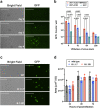Neutralizing activity of Sputnik V vaccine sera against SARS-CoV-2 variants
- PMID: 34312390
- PMCID: PMC8313705
- DOI: 10.1038/s41467-021-24909-9
Neutralizing activity of Sputnik V vaccine sera against SARS-CoV-2 variants
Abstract
Severe acute respiratory syndrome coronavirus 2 (SARS-CoV-2) has infected at least 180 million people since its identification as the cause of the current COVID-19 pandemic. The rapid pace of vaccine development has resulted in multiple vaccines already in use worldwide. The contemporaneous emergence of SARS-CoV-2 'variants of concern' (VOC) across diverse geographic locales underscores the need to monitor the efficacy of vaccines being administered globally. All WHO designated VOC carry spike (S) polymorphisms thought to enable escape from neutralizing antibodies. Here, we characterize the neutralizing activity of post-Sputnik V vaccination sera against the ensemble of S mutations present in alpha (B.1.1.7) and beta (B.1.351) VOC. Using de novo generated replication-competent vesicular stomatitis virus expressing various SARS-CoV-2-S in place of VSV-G (rcVSV-CoV2-S), coupled with a clonal 293T-ACE2 + TMPRSS2 + cell line optimized for highly efficient S-mediated infection, we determine that only 1 out of 12 post-vaccination serum samples shows effective neutralization (IC90) of rcVSV-CoV2-S: B.1.351 at full serum strength. The same set of sera efficiently neutralize S from B.1.1.7 and exhibit only moderately reduced activity against S carrying the E484K substitution alone. Taken together, our data suggest that control of some emergent SARS-CoV-2 variants may benefit from updated vaccines.
© 2021. The Author(s).
Conflict of interest statement
B.L., C.S., and K.Y.O. are named inventors on a patent filed by the Icahn School of Medicine, which includes the 293T-ACE2-TMPRSS2 (F8-2) cells used for the virus neutralization assay. J.P.K. is a consultant for BioNTech (advisory panel on coronavirus variants). The remaining authors declare no competing interests.
Figures





Update of
-
Neutralizing activity of Sputnik V vaccine sera against SARS-CoV-2 variants.medRxiv [Preprint]. 2021 May 29:2021.03.31.21254660. doi: 10.1101/2021.03.31.21254660. medRxiv. 2021. Update in: Nat Commun. 2021 Jul 26;12(1):4598. doi: 10.1038/s41467-021-24909-9. PMID: 33821288 Free PMC article. Updated. Preprint.
-
Neutralizing activity of Sputnik V vaccine sera against SARS-CoV-2 variants.Res Sq [Preprint]. 2021 Apr 8:rs.3.rs-400230. doi: 10.21203/rs.3.rs-400230/v1. Res Sq. 2021. Update in: Nat Commun. 2021 Jul 26;12(1):4598. doi: 10.1038/s41467-021-24909-9. PMID: 33851150 Free PMC article. Updated. Preprint.
References
-
- Center for Systems Science and Engeineering at Johns Hopkins University. COVID-19 Map-Johns Hopkins Coronavirus Resource Center. https://coronavirus.jhu.edu/map.html (2021).
Publication types
MeSH terms
Substances
Grants and funding
LinkOut - more resources
Full Text Sources
Other Literature Sources
Medical
Miscellaneous

